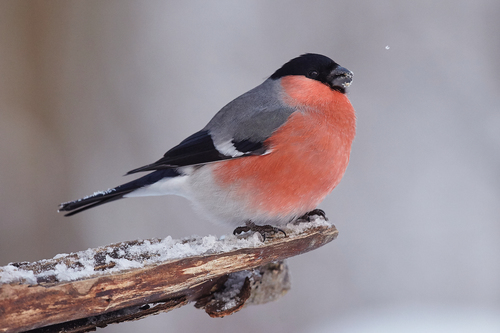
Eurasian Bullfinch
The Eurasian Bullfinch (*Pyrrhula pyrrhula*) is a small, plump passerine bird known for its distinctive rosy-red breast and cheeks in males, contrasting with a black cap and grey back. Females and juveniles exhibit a more subdued buff-brown coloration. This species plays a significant role in seed dispersal within its woodland and orchard habitats. While generally not considered a bird of significant cultural importance like some other finches, it is often featured in European folklore and art, sometimes symbolizing winter or resilience due to its ability to thrive in colder climates. Its shy nature and preference for dense cover make it a rewarding, though sometimes challenging, bird to observe.
14.5-16 cm
Length
22-29 cm
Wingspan
Least Concern
Conservation Status
Distribution
The Eurasian Bullfinch has a wide distribution across Europe and Asia, extending from the British Isles and Iberia eastward across Russia to Japan. It is found in both temperate and boreal regions. Migratory patterns vary; northern populations tend to be more migratory, moving south for the winter, while southern populations are often resident.
Lifespan
Typically 2-3 years in the wild, but can live longer in captivity (up to 17 years recorded).
Eurasian Bullfinch's Habitat
Habitat Types
Coniferous forests, Mixed woodlands, Hedgerows, Orchards, Parks and gardens (with sufficient cover)
Climate Zones
Temperate, Boreal
Adaptations
The Bullfinch's robust bill is well-adapted for cracking seeds and buds, a crucial adaptation for surviving in areas with seasonal food availability. Their relatively sedentary nature, except in the harshest climates, allows them to conserve energy during winter months.
Variations
Several subspecies of *Pyrrhula pyrrhula* are recognized, differing slightly in size, plumage coloration, and bill morphology. These variations are often linked to geographic isolation and adaptation to local food sources. For example, some island populations may exhibit darker plumage.
Appearance
Breeding Plumage
Adult males have a bright rosy-red breast, cheeks, and belly, a black cap and face, a grey back, and white rump. Females and juveniles have a buff-brown breast and underparts, retaining the black cap and grey back, but lacking the bright red coloration. There's little seasonal variation beyond a slight dulling of the male's red outside the breeding season.
Seasonal Feather Changes
Minor. Colors may be slightly brighter during breeding season.
Sex Based Plumage Differences
Significant. Males are brightly colored with red, while females are predominantly brown and grey.
Notable Features
Black cap extending to below the eye, Thick, stubby black bill, White rump, conspicuous in flight, Black wings with a single, prominent white wing bar
Diet and Feeding
Primary Foods
Seeds, Buds (especially of fruit trees), Berries, Insects (primarily during breeding season)
Foraging Behavior
Bullfinches typically forage in trees and shrubs, often in small flocks, especially outside the breeding season. They are adept at clinging to branches and extracting seeds from buds and cones. They may also forage on the ground for fallen seeds.
Specializations
Their strong, conical bill is perfectly adapted for cracking open seeds and buds. This allows them to access food sources that are unavailable to birds with weaker bills.
Seasonal Diet Variations
Their diet shifts seasonally. In spring and summer, they consume more insects and buds, providing protein for breeding and growing chicks. In autumn and winter, they rely heavily on seeds and berries.
Behavior
Social Structure
Eurasian Bullfinches are generally found in pairs or small family groups. During the non-breeding season, they may form larger flocks, sometimes mixed with other finch species.
Communication
Soft, piping calls, A low, mournful whistle, Visual displays during courtship
Migration
Northern populations are typically migratory, moving south for the winter. Southern populations are often resident or only undertake short-distance movements.
Territorial or Group Behaviors
During the breeding season, males are territorial, defending the area around the nest. Outside the breeding season, they are more social and often forage in flocks.
Conservation
Threats
Habitat loss (due to deforestation and agricultural intensification), Changes in woodland management practices, Pesticide use (reducing insect prey availability), Historically, persecution by fruit growers (due to bud damage)
Protection Programs
Habitat restoration and management initiatives, Agri-environment schemes promoting biodiversity-friendly farming practices
Local National Laws
Protected under various national and international wildlife legislation, such as the EU Birds Directive.
Population Trend
Stable
Population Estimates
The global population is estimated to be very large (tens of millions), and although there have been some localized declines, the overall population is considered stable.
Interesting Facts
Bullfinches are known for their ability to mimic sounds.
Although not as accomplished mimics as some other birds, they can learn and repeat simple melodies.
They have a reputation for damaging fruit tree buds.
While they do eat buds, the extent of the damage is often overstated, and they also consume weed seeds, providing a beneficial service.
The Bullfinches found in the Azores ( *Pyrrhula murina*) were once considered a subspecies of the Eurasian Bullfinch, but are now listed as a separate species.
The Azores Bullfinch is critically endangered.
The name "bullfinch" refers to the bird's thick neck and robust build, resembling that of a bull.
This physical characteristic is reflected in the bird's common name.
Faqs about Eurasian Bullfinch
What is the difference between a male and female Bullfinch?
Male Bullfinches have a bright rosy-red breast and cheeks, while females are a duller buff-brown color.
Are Bullfinches rare?
No, Bullfinches are not rare across their range, although they can be locally uncommon due to habitat loss or other factors. They are classified as Least Concern by the IUCN.
Do Bullfinches migrate?
Northern populations of Eurasian Bullfinches are migratory, while southern populations are generally resident.
What do Bullfinches eat?
Bullfinches primarily eat seeds, buds, berries, and insects (especially during the breeding season).
Where do Bullfinches nest?
Bullfinches build cup-shaped nests in dense bushes or trees, typically low to the ground.
Copyright @ Nature Style Limited. All Rights Reserved.
 English
English